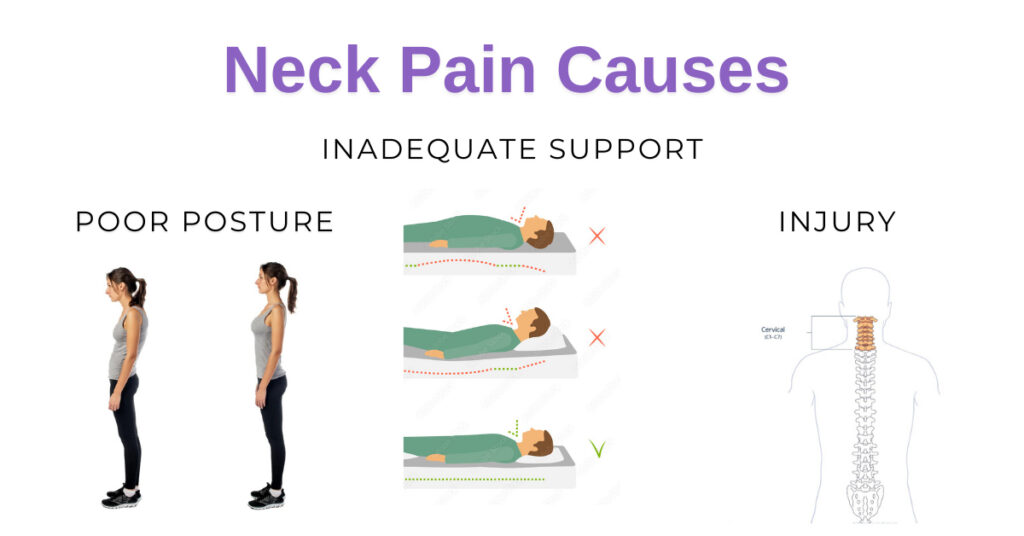A good pillow for neck pain provides proper support and maintains spinal alignment. Memory foam or cervical pillows are ideal choices.
Neck pain can significantly impact your daily life and sleep quality. Choosing the right pillow is crucial for alleviating discomfort. Memory foam pillows contour to your neck and head, offering personalized support. Cervical pillows are specifically designed to maintain the natural curve of your spine.
These types of pillows help reduce strain on your neck muscles. Proper support prevents stiffness and promotes better sleep posture. Investing in a high-quality pillow can lead to noticeable improvements. It’s essential to consider your sleeping position and personal comfort preferences. A well-chosen pillow can make a significant difference in managing neck pain effectively.
Types Of Pillows
Neck pain can be a real problem, especially at night. Choosing the right pillow is crucial. A good pillow for neck pain should provide support and comfort. There are several types of pillows available. Each type offers unique benefits. This guide will help you understand the best pillow options for neck pain.
Memory Foam
Memory foam pillows are popular for their supportive nature. They mold to the shape of your neck and head. This molding effect provides excellent support and can help reduce neck pain.
Memory foam pillows offer several benefits:
- Conform to the shape of your neck and head
- Provide consistent support throughout the night
- Often come with cooling features to prevent overheating
Memory foam pillows also come in different shapes. Some are contoured to provide extra support. Others are traditional-shaped but still offer the benefits of memory foam.
Here is a comparison table for memory foam pillow features:
|
Feature |
Description |
|
Support |
High |
|
Comfort |
Medium to High |
|
Cooling |
Available in some models |
Latex
Latex pillows are known for their durability and supportive properties. They are made from natural or synthetic latex. Latex pillows are often firm yet comfortable. This makes them a good choice for people with neck pain.
Benefits of latex pillows include:
- Long-lasting and durable
- Supportive and helps maintain neck alignment
- Resistant to dust mites and allergens
Latex pillows come in different shapes and sizes. Some are contoured for extra neck support. Others are traditional-shaped but still provide great support. Latex pillows are also breathable, which helps keep you cool at night.
Here is a comparison table for latex pillow features:
|
Feature |
Description |
|
Support |
High |
|
Comfort |
High |
|
Cooling |
Good |
Feather
Feather pillows are soft and luxurious. They are filled with feathers from ducks or geese. Feather pillows can be adjusted to provide the right level of support. This makes them a good option for neck pain relief.
Benefits of feather pillows include:
- Soft and comfortable
- Adjustable to your preferred support level
- Lightweight and easy to handle
Feather pillows can provide support, but they may need frequent fluffing. This helps maintain their shape and support. They can also be combined with other materials for better support.
Here is a comparison table for feather pillow features:
|
Feature |
Description |
|
Support |
Medium |
|
Comfort |
High |
|
Cooling |
Good |

Pillow Shape
Neck pain can be a real problem in daily life. Choosing the right pillow shape helps. Different pillow shapes offer various benefits. This guide explains the best pillow shapes for neck pain relief.
Contour
Contour pillows have a unique design. They have a dip in the middle. This dip supports the neck and head. These pillows align the spine properly. Good alignment reduces neck pain. Many people find relief with contour pillows. They are made from memory foam often. Memory foam molds to the shape of your neck and head.
Here are some benefits of contour pillows:
- Proper spinal alignment
- Neck and head support
- Pain relief
- Memory foam molds to shape
Contour pillows come in different sizes. Choose one that fits your body size. Some have cooling gel. Cooling gel can help you sleep better. If you have neck pain, try a contour pillow. It might be the solution you need.
Traditional
Traditional pillows have a simple shape. They are rectangular and fluffy. These pillows come in many materials. Common materials include cotton, polyester, and down. Traditional pillows are easy to find. They are also affordable.
Here are some benefits of traditional pillows:
- Affordable and easy to find
- Variety of materials available
- Simple and classic design
Some traditional pillows offer good support. Look for pillows with firm filling. Firm filling helps keep your neck aligned. You can also try a pillow with extra loft. Extra loft provides more support for the neck.
Adjustable
Adjustable pillows let you change their shape. You can add or remove filling. This helps you find the perfect support. Adjustable pillows are great for neck pain relief. They adapt to your needs.
Here are some benefits of adjustable pillows:
- Customizable support
- Adaptable to your needs
- Good for neck pain relief
These pillows can be filled with various materials. Memory foam and shredded foam are common. You can add or remove filling as needed. This makes the pillow firmer or softer. Adjustable pillows are versatile. They work well for many people. If you have neck pain, try an adjustable pillow. It allows you to find the perfect fit for your needs.
Sleeping Positions
Neck pain can be debilitating and disrupts sleep. A good pillow can alleviate neck pain by providing proper support. Choosing the right pillow depends on sleeping positions. Different positions require different pillow types to ensure comfort and neck alignment.
Back Sleepers
Back sleepers need a pillow that supports the natural curve of the spine. A medium-loft pillow is ideal, as it keeps the head aligned with the spine. This type of pillow ensures that the neck is not strained.
Important features for back sleepers include:
- Medium firmness for balanced support
- Contour design to cradle the head and neck
- Memory foam or latex for even distribution of weight
Memory foam pillows often work well for back sleepers. These pillows adjust to the shape of the head and neck, providing customized support. Latex pillows also offer great support and are hypoallergenic.
|
Feature |
Benefit |
|
Medium Firmness |
Balanced support for neck and spine |
|
Contour Design |
Cradles head and neck |
|
Memory Foam |
Even weight distribution |
Side Sleepers
Side sleepers need a pillow that fills the gap between the head and shoulders. A high-loft pillow is essential to keep the spine aligned. Without proper support, the neck can bend unnaturally, causing pain.
Key features for side sleepers include:
- High firmness to maintain alignment
- Adjustable loft for personalized comfort
- Cooling properties to prevent overheating
Adjustable pillows are great for side sleepers. They allow users to add or remove filling to find the perfect height. Cooling gel-infused memory foam pillows can also help regulate temperature, ensuring a comfortable sleep.
|
Feature |
Benefit |
|
High Firmness |
Keeps spine aligned |
|
Adjustable Loft |
Customizable support |
|
Cooling Properties |
Temperature regulation |
Stomach Sleepers
Stomach sleepers need a low-loft pillow to avoid neck strain. A soft, thin pillow is ideal for this position. This helps keep the spine in a neutral position.
Important features for stomach sleepers include:
- Low loft to reduce neck strain
- Soft materials for comfort
- Breathability to keep cool
Thin memory foam or down pillows often work best for stomach sleepers. These pillows provide the right amount of support without lifting the head too much. Breathable materials like cotton covers can help keep the pillow cool.
|
Feature |
Benefit |
|
Low Loft |
Reduces neck strain |
|
Soft Materials |
Enhanced comfort |
|
Breathability |
Keeps pillow cool |

Firmness Levels
Neck pain can disrupt sleep and daily life. Choosing the right pillow can help. A pillow’s firmness plays a vital role in providing comfort and support. Different firmness levels suit different needs. Understanding these levels can help you find the perfect pillow for neck pain.
Soft
Soft pillows are great for those who sleep on their stomachs. They provide less support but offer a plush feel. This can help keep the neck in a neutral position. Here are some features of soft pillows:
- Plush and comfortable
- Less neck support
- Best for stomach sleepers
Soft pillows can flatten over time. This may lead to less effective support. Regularly checking and replacing them is essential. People with neck pain might find soft pillows less beneficial. They often need more support to keep the neck aligned.
Medium
Medium pillows offer a balance between softness and support. They are suitable for back and side sleepers. These pillows help maintain the natural curve of the neck. Here are some key points:
- Balanced support and comfort
- Good for back and side sleepers
- Helps maintain neck alignment
Medium pillows often contain materials like memory foam. This material adapts to the shape of your neck. This provides consistent support. They are also durable and retain their shape longer than soft pillows.
Firm
Firm pillows provide the most support. They are ideal for side sleepers. Firm pillows help keep the neck and spine aligned. Here are some important features:
- Maximum support for the neck
- Best for side sleepers
- Helps reduce neck and shoulder pain
Firm pillows often contain materials like latex or high-density memory foam. These materials provide robust support. They can be a bit less comfortable for some people. Testing different firmness levels can help you find the best fit for your needs.
Material Benefits
Neck pain can be a persistent issue that affects your daily life. Choosing the right pillow can make a significant difference. The material of the pillow plays a crucial role in providing the necessary support and comfort. This blog post will explore the benefits of different materials, focusing on cooling properties, hypoallergenic options, and durability.
Cooling Properties
The best pillows for neck pain often have cooling properties. These pillows help regulate temperature and keep you comfortable throughout the night. Cooling pillows can be made from various materials such as gel-infused memory foam or latex.
- Gel-Infused Memory Foam: This material disperses heat, keeping the pillow cool.
- Latex: Natural latex is breathable and stays cool all night.
- Bamboo Covers: Bamboo fabric is breathable and helps in cooling.
Cooling pillows can prevent night sweats and improve sleep quality. It’s crucial to choose a pillow that offers both support and temperature regulation. This combination can help reduce neck pain and improve overall sleep health.
Hypoallergenic Options
Hypoallergenic pillows are essential for people with allergies. These pillows are made from materials that resist dust mites, mold, and other allergens. Common hypoallergenic materials include memory foam, latex, and synthetic fibers.
- Memory Foam: Memory foam is resistant to dust mites and mold.
- Latex: Natural latex is hypoallergenic and breathable.
- Synthetic Fibers: Polyester and other synthetic fibers can be hypoallergenic.
Using a hypoallergenic pillow can improve sleep quality and reduce allergic reactions. It’s important to choose a pillow that offers both support and hypoallergenic properties. This combination can help alleviate neck pain and improve overall health.
Durability
Durability is a key factor when choosing a pillow for neck pain. A durable pillow will provide consistent support for a longer period. Materials like memory foam and latex are known for their durability.
|
Material |
Durability |
|
Memory Foam |
5-7 years |
|
Latex |
7-10 years |
|
Polyester |
1-2 years |
Investing in a durable pillow can save you money in the long run. A durable pillow will maintain its shape and support, reducing the need for frequent replacements. This can help in maintaining neck alignment and reducing pain over time.
Neck Pain Causes
A good pillow can ease neck pain. Neck pain has many causes. Understanding these causes helps in choosing the right pillow. Proper support while sleeping is key. Let’s explore common causes of neck pain.
Poor Posture
Poor posture is a common cause of neck pain. Sitting or standing incorrectly strains the neck muscles. Slouching is a big culprit. It causes the head to lean forward, stressing the neck. Hunching over devices like phones or laptops also leads to neck pain.
To improve posture, follow these tips:
- Sit up straight with shoulders back.
- Keep screens at eye level to avoid looking down.
- Take breaks to stretch and move around.
Using a pillow that supports the natural curve of the neck helps. The pillow should keep the head aligned with the spine. This reduces strain and promotes better posture even while sleeping.
Inadequate Support
Inadequate support from a pillow can lead to neck pain. A pillow that is too soft or too firm can cause discomfort. Proper support means the pillow should maintain the natural curve of the neck. It should not be too high or too low.
Types of pillows that offer good support:
|
Pillow Type |
Benefits |
|
Memory Foam |
Contours to the shape of your head and neck. |
|
Orthopedic |
Designed to support the neck’s natural curve. |
|
Feather |
Adjusts easily to the shape of your neck. |
Choosing the right pillow involves personal preference. It should feel comfortable and provide adequate support. A good pillow helps in maintaining the right alignment of the neck and spine.
Injury
Neck injuries can cause significant pain. Injuries like whiplash or muscle strain are common. They result from accidents, falls, or sudden movements. Such injuries cause inflammation and restrict movement.
Rest and proper support are crucial for recovery. A supportive pillow can alleviate pain by keeping the neck in a neutral position. This reduces strain on injured muscles and ligaments.
Other tips for managing neck pain due to injury:
- Apply ice to reduce swelling.
- Use heat packs to soothe muscles.
- Avoid sudden movements that can worsen the injury.
Consulting a healthcare provider is important for severe injuries. They can recommend specific pillows or treatments. Proper care and support help in faster recovery and reducing pain.

Choosing The Right Height
Neck pain can be a nightmare, especially when it disrupts your sleep. The right pillow can make a big difference. A good pillow for neck pain offers support and comfort, helping you wake up refreshed. One key factor is choosing the right height. Let’s delve into how to select the perfect pillow height.
Shoulder Width
Shoulder width plays a crucial role in picking a pillow. A wider shoulder needs a thicker pillow. A narrow shoulder might need a thinner pillow. This ensures proper alignment of the neck and spine.
Here are some tips:
- If you have broad shoulders, choose a high-loft pillow.
- If you have narrow shoulders, go for a low-loft pillow.
- Measure your shoulder width for the best fit.
Ensuring the pillow matches your shoulder width helps keep your neck in a neutral position. This reduces stress and pain in the neck area. It is essential for side sleepers, as their shoulders take more weight.
Mattress Type
The type of mattress impacts pillow height. A soft mattress lets you sink in, needing a lower pillow. A firm mattress keeps you on top, needing a higher pillow.
Here’s how to match pillow height with mattress type:
|
Mattress Type |
Pillow Height |
|
Soft Mattress |
Low-Loft Pillow |
|
Medium Mattress |
Medium-Loft Pillow |
|
Firm Mattress |
High-Loft Pillow |
Matching pillow height with mattress type ensures proper spinal alignment. This can prevent neck pain and improve sleep quality. Always consider both your mattress and pillow for optimal comfort.
Personal Preference
Personal preference is vital in choosing a pillow. Comfort is subjective. What works for one person may not work for another. It is essential to try different pillows to find what feels best.
Consider these factors:
- Pillow material: memory foam, latex, feather, or down.
- Pillow firmness: soft, medium, or firm.
- Sleeping position: back, side, or stomach.
Trying different types and firmness levels can help you discover your ideal pillow. Your comfort and support needs should guide your choice. Don’t hesitate to experiment until you find the perfect match.
Pillow Maintenance
Neck pain can be a real hassle, and your pillow might be the culprit. A good pillow for neck pain must offer proper support and comfort. But maintaining your pillow is just as important as choosing the right one. Proper care can extend your pillow’s life and keep it effective in providing relief. In this blog post, we’ll dive into how to maintain your pillow to ensure it continues to support your neck properly.
Washing Instructions
Keeping your pillow clean is crucial for neck health. Dirt and allergens can worsen neck pain. Here are some washing instructions to help you care for your pillow:
- Check the label: Always read the care label on your pillow. It provides specific washing instructions.
- Use a gentle detergent: Choose a mild, non-toxic detergent to avoid skin irritation.
- Wash in cool water: Hot water can damage the pillow’s material. Use cool or lukewarm water instead.
- Gentle cycle: Set your washing machine to a gentle cycle to prevent wear and tear.
Drying your pillow properly is just as important. Improper drying can lead to mold growth. Follow these steps for drying:
- Air dry: If possible, air dry your pillow in a well-ventilated area.
- Use a dryer: If using a dryer, set it to a low heat setting. Add dryer balls to help fluff the pillow.
- Ensure complete dryness: Make sure the pillow is completely dry before use to prevent mold.
Replacement Frequency
Even the best pillow will wear out over time. Knowing when to replace your pillow is key to maintaining neck support. Here are some signs it’s time for a new pillow:
- Lumps and bumps: If your pillow is lumpy, it can’t support your neck properly.
- Flattening: A pillow that has lost its fluffiness won’t offer adequate support.
- Odor: If your pillow has a persistent smell, it might be time to replace it.
- Neck pain: Ongoing neck pain may indicate your pillow is no longer effective.
As a general rule, replace your pillow every one to two years. Different types of pillows have different lifespans:
|
Pillow Type |
Replacement Frequency |
|
Memory Foam |
2-3 years |
|
Feather |
1-2 years |
|
Synthetic |
6 months to 2 years |
Storage Tips
Proper storage can extend your pillow’s life. Here are some tips for storing your pillow:
- Use a pillowcase: Always use a clean pillowcase to protect your pillow from dust and dirt.
- Store in a cool, dry place: Moisture can cause mold and mildew. Keep your pillow in a dry area.
- Avoid compression: Don’t stack heavy items on your pillow. It can flatten and deform it.
- Use a breathable bag: If you need to store your pillow for a long time, use a breathable storage bag to allow air circulation.
Proper storage ensures your pillow stays clean and retains its shape. This helps maintain the support your neck needs.
Customer Reviews
Finding the right pillow can make a huge difference for people with neck pain. Customer reviews can help identify the best options. This guide explores top picks, common complaints, and user experiences to help you find the perfect pillow.
Top Picks
Choosing a pillow can be confusing. Here are some top-rated pillows based on customer reviews:
- Memory Foam Pillows: Many users praise these for their ability to mold to the shape of the neck.
- Contour Pillows: These pillows offer extra support to align the neck and spine.
- Latex Pillows: Known for their durability and firmness, these pillows are great for maintaining neck support.
Below is a table summarizing the features of these top picks:
|
Pillow Type |
Features |
Pros |
Cons |
|
Memory Foam |
Molds to neck shape |
Custom support |
Can retain heat |
|
Contour |
Aligns neck and spine |
Extra support |
Firmness varies |
|
Latex |
Durable and firm |
Long-lasting |
Can be too firm |
Common Complaints
Even the best pillows have drawbacks. Here are some common complaints from users:
- Heat Retention: Many memory foam pillows tend to get hot during the night.
- Firmness Issues: Some people find contour pillows either too firm or too soft.
- Allergies: Latex pillows can cause allergies in sensitive individuals.
Understanding these complaints can help in making a better choice. Always check the reviews before purchasing. This can save you from a lot of discomfort.
User Experiences
Real user experiences can offer valuable insights. Here are some shared by users:
John: “My neck pain reduced significantly after switching to a memory foam pillow. It molds perfectly to my neck.”
Sarah: “I tried a contour pillow, but it was too firm for me. It didn’t help my neck pain.”
Mike: “Latex pillows are great for me. They are firm and supportive. However, my wife is allergic to them.”
These experiences highlight the importance of personal preference. What works for one person may not work for another. Trying different types can help find the best match for your needs.

Expert Recommendations
Finding the right pillow can be a game-changer for those suffering from neck pain. Experts have different recommendations based on their fields of expertise. This blog post will explore advice from chiropractors, sleep specialists, and physical therapists. Understanding their perspectives can help you choose the best pillow to alleviate neck pain.
Chiropractors
Chiropractors emphasize the importance of spinal alignment to reduce neck pain. They often recommend pillows that support the natural curve of the spine. Here are some key features they suggest:
- Firmness: A medium-firm pillow maintains alignment without being too hard.
- Material: Memory foam or latex options offer good support and shape retention.
- Shape: Contoured pillows can provide added neck support.
Chiropractors also advise that the pillow’s height should match your sleeping position. For back sleepers, a lower pillow is often better. Side sleepers may benefit from a higher pillow to fill the gap between the neck and shoulder.
|
Sleeping Position |
Recommended Pillow Height |
|
Back Sleeper |
Low |
|
Side Sleeper |
High |
Sleep Specialists
Sleep specialists focus on the overall quality of sleep. A good pillow can significantly impact sleep quality. They recommend pillows that provide both comfort and support. Here are their key tips:
- Adjustability: Pillows with adjustable filling allow you to customize the height and firmness.
- Breathability: Materials like gel-infused memory foam or natural fibers help regulate temperature.
- Hypoallergenic: Pillows made from hypoallergenic materials can prevent allergic reactions.
Sleep specialists also highlight the importance of replacing pillows regularly. An old pillow may lose its shape and support, leading to neck pain. They suggest replacing your pillow every 1-2 years for optimal comfort and support.
Physical Therapists
Physical therapists often work with patients who have chronic neck pain. They recommend pillows that support the neck muscles and reduce strain. Some of their key recommendations include:
- Ergonomic Design: Pillows with an ergonomic design can help reduce neck strain.
- Memory Foam: Memory foam pillows mold to the shape of your neck, providing customized support.
- Height and Firmness: The height and firmness should match your specific needs.
Physical therapists also suggest using a pillow that promotes a neutral spine position. This helps in reducing muscle tension and improving overall comfort. They might also recommend specific exercises to strengthen neck muscles and alleviate pain.
Frequently Asked Questions
What Type Of Pillow Is Best For Neck Pain?
A memory foam pillow is often best for neck pain. It provides excellent support and maintains spinal alignment.
How Firm Should A Pillow Be For Neck Pain?
A medium-firm pillow is ideal for neck pain. It supports the neck without causing additional strain.
Can A Pillow Cause Neck Pain?
Yes, an unsuitable pillow can cause neck pain. Pillows that are too flat or too high can disrupt neck alignment.
Is A Cervical Pillow Good For Neck Pain?
A cervical pillow can be very effective. It supports the natural curve of your neck, reducing pain and discomfort.
How Often Should You Replace Your Pillow?
Replace your pillow every 1-2 years. Old pillows can lose support and contribute to neck pain.
Conclusion
Finding the right pillow can significantly reduce neck pain. Prioritize support, comfort, and material when choosing your pillow. Memory foam and cervical pillows are top options. Always test different types to find what suits you best. Your neck will thank you for making the right choice.
Sleep well and wake up pain-free!

